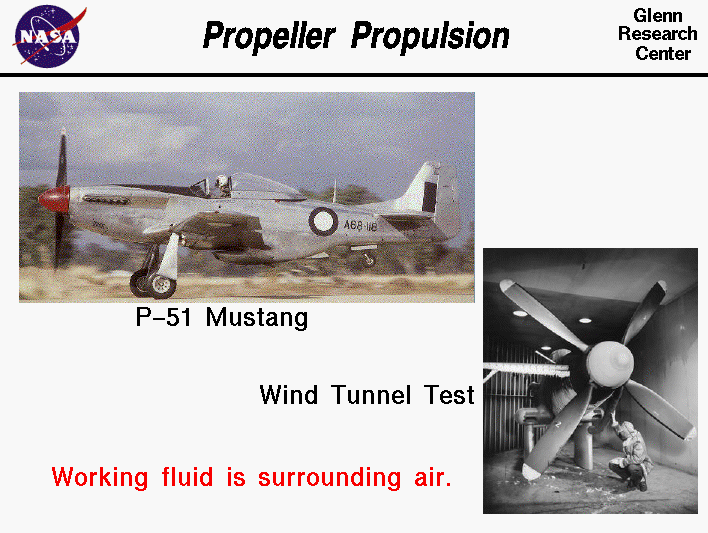
Thrust is the force which moves any
aircraft through the air. Thrust is generated by the
propulsion system
of the aircraft. Different propulsion systems develop thrust in
different ways, but all thrust is generated through some
application of Newton's third law of
motion. For every action there is an equal and opposite reaction.
In any propulsion system, a working fluid is
accelerated by the system and
the reaction to this acceleration produces a force on the system. A
general derivation of the thrust equation
shows that the amount of thrust generated depends on the
mass flow
through the engine and the
change in velocity of the gas going through the propulsion system.
Propeller-Produced Thrust
For the forty years following the
first flight
of the Wright brothers, airplanes used
internal combustion engines
to turn propellers to
generate thrust. Today, most general aviation or private airplanes are still
powered by propellers and internal combustion engines, much like your
automobile engine. The engine
takes air
from the surroundings, mixes
it with fuel, burns the fuel to release
the energy in the fuel, and uses the heated gas exhaust to move a
piston
which is attached to a crankshaft. In the automobile, the
shaft is used to turn the wheels of the car. In an airplane, the
shaft is connected to a propeller.
Propellers as Airfoils
On this slide, we show pictures of a P-51 propeller-powered
airplane from World War II and a propeller being tested in a NASA
Glenn wind tunnel. The details of
propeller propulsion are very complex, but we can learn some of the
fundamentals by using a simple momentum
theory. The details are complex because the propeller acts like a
rotating wing creating a lift force by
moving through the air. For a propeller-powered aircraft, the gas
that is accelerated, or the working fluid, is the
surrounding air that passes through the propeller. The air that is
used for combustion in the engine provides very little thrust.
Propellers can have from 2 to 6 blades. As shown in the wind tunnel
picture, the blades are usually long and thin. A cut through the
blade perpendicular to the long dimension will give an airfoil
shape. Because the blades rotate, the tips moves faster than the
hub. So to make the propeller efficient, the blades are usually
twisted from hub to tip. The angle of attack of the
airfoils at the tip is lower than at the hub.
Other Engines Drive Propellers
As noted, the engine used in the P-51 was an internal combustion
engine. After World War II, as jet
engines gained popularity, aerodynamicists used jet engines to
turn the propellers on some aircraft. This propulsion system is
called a turboprop. A C-130 transport plane
is a turboprop aircraft. Its main thrust comes from the propellers,
but the propellers are turned by turbine engines. The human-powered
aircraft of the mid 80's were also propeller-powered, but the
"engine" was provided by a human using a bicycle gearing device.
Currently NASA is flying a solar-powered, electric engine aircraft
that also uses propellers.
Propeller-powered aircraft are very efficient for
low speed flight. But as the speed of the aircraft
increases, regions of
supersonic flow,
with associated performance losses due to
shock waves, occur on the propeller.
Propellers are not used on
high speed
aircraft.
Activities:




Guided Tours
-
 Propulsion Systems:
Propulsion Systems:

-
 Propellers:
Propellers:

Navigation ..

- Beginner's Guide Home Page
|
